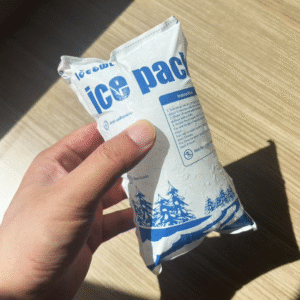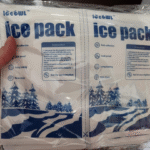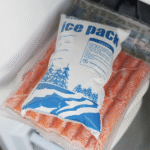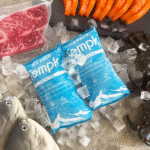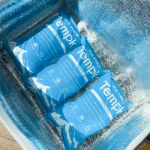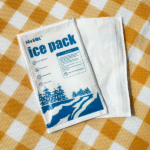Paquetes de hielo seco frente a hielo seco: Cómo elegir en 2025
Elegir entre bolsas de hielo seco versus hielo seco establece directamente su control de temperatura, necesidades de cumplimiento, y costo total. El hielo seco se encuentra a -78,5 °C y normalmente se sublima aproximadamente 5–10 lb por 24h, mientras que los paquetes de gel/PCM contienen puntos de ajuste estrechos para carriles congelados refrigerados o moderados. Elija el que proteja su producto y simplifica las operaciones bajo las reglas actuales del transportista y de la IATA.
-
Cuándo usar cada opción por 2–8 ° C, espeluznante, helado, y carriles ultrafríos
-
Cómo dimensionar el refrigerante rápidamente con reglas sencillas que puedes validar en una ejecución piloto
-
2025 elementos esenciales de cumplimiento (IATA/PHMSA/USPS) con prácticos consejos de etiquetado y ventilación
-
Seguridad, costo, y compensaciones de sostenibilidad para reducir el riesgo y el gasto
-
Recetas de empaque prácticas Puedes poner tu línea hoy.
¿Cuándo debería elegir bolsas de hielo seco frente a hielo seco para cada objetivo de temperatura??
Respuesta corta: Use paquetes de gel/PCM para 2–8 ° C y muchos SKU "Soft -Frozen"; Use hielo seco para el profundo profundo (≤ - 20 ° C) o necesidades ultrafrías. Esto evita la congelación de alimentos delicados y le permite cumplir con los carriles de paquetes rutinarios.. Agregue un pequeño adorno de hielo seco solo cuando el calor o la duración prolongada lo exijan..
Por que esto funciona: Los refrigerantes se “mantienen” cerca de su temperatura de cambio de fase. Los geles de agua se mantienen cerca de 0°C; Los PCM pueden contener −7/−16/−21°C; El hielo seco se mantiene cerca de -78,5°C.. Haga coincidir la temperatura del producto más baja permitida con la del refrigerante para evitar el sobrecongelamiento o el calentamiento durante los picos del último kilómetro.. Los mariscos vivos deben no barco con hielo seco; usar gel/PCM con ventilación.
¿Cómo se comparan los PCM a -21 °C con el hielo seco para carriles congelados??
Detalle: Los ladrillos PCM a -21 °C pueden mantener muchos alimentos congelados dentro de las especificaciones durante 24 a 72 h en contenedores aislados, evitando al mismo tiempo pasos con materiales peligrosos y riesgo de quemaduras por contacto. Para carriles ≥72h o cargas útiles ultrafrías, El hielo seco todavía lidera. Pilotar un híbrido (Núcleo PCM + Pequeño topper de hielo seco) para temporadas calurosas y rutas variables.
| Opción de enfriamiento | Objetivo típico | Señal de duración aproximada* | Lo que significa para ti |
|---|---|---|---|
| Paquete de gel (0 ° C) | 2–8 ° C | 12–48h | Ideal para kits de comida, lácteos; operaciones simples |
| PCM -21 ° C | Alt congelado | 24–72h | Reutilizable; Saltar materiales peligrosos en muchos carriles. |
| hielo seco | ≤ - 20 ° C / ultrafrío | ~ 5–10 lb por 24h | Largo, rutas calientes; requiere ventilación & etiquetas |
* Validar con su masa de carga útil, aislamiento, ruta, y el clima.
Consejos prácticos
-
Enfriado 2–8°C, ≤48h: Caja y carga útil de preenfriamiento; Utilice paquetes de gel a 0 °C alrededor y encima de la carga..
-
Helado −12 a −18°C: Envolvente con PCM de −16/−21 °C; agregue un pequeño adorno de hielo seco para las olas de calor.
-
Hisopos/viales congelados: Utilice transportadores de hielo seco ventilados; masa neta récord de hielo seco; siga las marcas PI954.
Caso del mundo real: Un pastel derretido cortado en panadería regresa por 92% cambiando a −16°C PCM + gel en verano, y un pequeño adorno de hielo seco para >48 Carriles h: no es necesario pasar a hielo seco.
¿Cómo se dimensionan las bolsas de hielo seco frente al hielo seco de forma rápida y segura??
Regla general: hielo seco: Plan ~5–10 lb por 24h por caja. Geles/PCM: empezar cerca 15–30% de la masa de carga útil para carriles de 2 a 8 °C, luego sintoniza probando. Agregue siempre un margen de seguridad para las rutas de verano y retrasos en la última milla.
Hazlo práctico: Comience con estas líneas de base en su carril más popular, agregar un registrador de temperatura, e iterar. Para PCM, confirmar el preacondicionamiento completo. Para hielo seco, Evite contenedores herméticos y documente la masa neta en la etiqueta..
Fórmulas en el dorso de una servilleta (copiar/pegar en su SOP)
Qué 2025 Las reglas afectan más a las bolsas de hielo seco frente al hielo seco.?
Aire (IATA): El hielo seco es Y 1845, Clase 9. Marque el nombre de envío adecuado, Número de la ONU, y masa neta de hielo seco; usar ventilado embalaje. Se aplican controles de capacitación y aceptación.. Aire de USPS Caps hielo seco en ≤5 libras por envío postal y prohíbe la mayoría de los envíos postales internacionales. Los paquetes de gel/PCM no suelen ser peligrosos y omite estos pasos.
Ayudas de trabajo de transportista: Espere tamaños de etiqueta explícitos, recordatorios de ventilación, y abordar los requisitos de los principales operadores. Seguir la lista de verificación reduce las retenciones y el retrabajo para los equipos de cumplimiento..
¿En qué se diferencian la seguridad y las operaciones entre las bolsas de hielo seco y el hielo seco??
Exposición del trabajador: Proporcionar ventilación donde se coloca hielo seco.; Los límites de OSHA/NIOSH son 5,000 PPM TWA y 30,000 PPM STEL para Co₂. Mantenga a los transportistas ventilados; nunca envuelva las rejillas de ventilación cerradas. Utilice guantes criogénicos; evitar el contacto directo.
Manejo más sencillo con paquetes: Los geles/PCM comerciales normalmente no son tóxicos y son reutilizables.; deseche los geles filtrados según las instrucciones locales (basura, no drena). Las instrucciones claras del recipiente evitan problemas de contacto con los alimentos y daños por condensación..
¿Cómo son el costo y la sostenibilidad de las bolsas de hielo seco frente al hielo seco??
Perfil de costos: El hielo seco es un consumible recurrente con variaciones de disponibilidad ligadas al suministro de CO₂; paquetes/PCM son activos reutilizables con un costo inicial más alto pero un menor gasto por turno. Hibridación (Núcleo PCM + Pequeño topper de hielo seco) a menudo gana en carriles calientes o inciertos.
Sostenibilidad & EPR: Muchas regiones están ampliando los programas EPR de envases en 2025. Los programas de PCM reutilizables y las instrucciones claras sobre el final de su vida útil para los paquetes de gel pueden respaldar el cumplimiento y reducir las tarifas por residuos..
2025 tendencias que remodelan las bolsas de hielo seco frente al hielo seco
Descripción general de la tendencia: Ayudas de aceptación IATA actualizadas, persistente tensión regional de CO₂, adopción más amplia de PCM de -21 °C, y un mayor seguimiento de activos para la recuperación bidireccional del paquete están cambiando las decisiones en cada carril. Esperar más Paquetes de PCM validados para 2–8°C y muchos SKU congelados, con hielo seco reservado para temperaturas extremas ultrafrías o ≥72 h.
Último de un vistazo
-
Transportistas precalificados para temperaturas de 2 a 8 °C empareje los PCM con un mejor aislamiento para reducir las excursiones.
-
Notas de la FAA/industria enfatizar el tamaño de los pellets, diseño de contenedores, y reutilizar impactos en la sublimación: pruebe su paquete exacto.
-
Los programas de activos se expanden, respaldar los informes EPR y reducir el desperdicio de consumibles con el tiempo.
Insight del mercado: El suministro de CO₂ sigue siendo sensible a los flujos de subproductos y a los tiempos de mantenimiento. Mantener un PCM alternativo en su manual mejora la resiliencia durante picos de precios o interrupciones.
Herramienta de decisión del usuario: cual debería tú usar hoy?
-
Su producto debe llegar congelado (≤ - 20 ° C) o ultrafrío?
-
Sí → Empezar con hielo seco; considerar un híbrido para carriles calientes.
-
No → Ir gel/pcm por 2–8 ° C.
-
-
¿Tu viaje es ≥48h en verano??
-
Congelado → Hielo seco o híbrido; mejorar el aislamiento.
-
Enfriado → PCM con paredes más gruesas; agregue un margen de seguridad del 15 al 25 %.
-
-
¿Realiza envíos por aire o correo con frecuencia??
-
Sí → Paquetes reducir la fricción y el entrenamiento con materiales peligrosos.
-
Si se requiere hielo seco → Entrenar, etiqueta, y ventilación por 2025 normas.
-
Preguntas frecuentes
¿Cuánto hielo seco necesito para un envío de 48 horas??
Plan 10–20 libras por caja (≈ 5 a 10 libras por 24 h) y validar por carril y calidad de aislamiento.
¿Puedo mezclar gel/PCM y hielo seco en una caja??
Sí, muchos transportistas utilizan PCM alrededor del producto más Pequeño topper de hielo seco para extender el tiempo de espera. Mantenga el cargador ventilado y etiquetado.
¿Existen límites postales para el hielo seco en los EE. UU.??
Sí. Aire de USPS: ≤5 libras por envío postal; internacional generalmente está restringido. Confirme siempre las últimas reglas del operador.
¿Qué pasa con la exposición de los trabajadores al CO₂??
Seguir 5,000 PPM TWA / 30,000 PPM STEL guía, ventilar habitaciones pequeñas y vehículos, y usar guantes.
¿Qué debo usar para mariscos vivos??
Usar gel/pcm, no hielo seco, para evitar el riesgo de asfixia por CO₂.
Resumen & recomendaciones
Final: Paquetes de hielo seco versus hielo seco mapas de temperatura, duración, y cumplimiento. Los paquetes/PCM destacan en 2–8 ° C y muchos carriles congelados con menor fricción con materiales peligrosos; hielo seco domina ultrafrío y largo, rutas calientes. Validar con pequeños pilotos y registradores antes de escalar.
Siguientes pasos:
-
Asigne cada SKU a refrigerado o congelado.
-
Construya dos paquetes estándar (PCM y hielo seco/híbrido).
-
Ejecute validaciones de estilo ISTA para verano/invierno.
-
Equipos de entrenar en 2025 etiquetas, desfogue, y seguridad.
CTA: Listo para optimizar? Reserve una auditoría de paquete con Tempk.
Acerca de Tempk
Diseñamos y validamos envases de cadena de frío para alimentación y farmacia.. Nuestro reutilizable Soluciones de PCM y gel reducir excursiones, tiempo de entrenamiento, y costos por turno, mientras que nuestros procedimientos operativos estándar para hielo seco mantienen el cumplimiento de los carriles ultrafríos. Los clientes ven menos RMA a través de masa de refrigerante del tamaño adecuado, mejor aislamiento, y documentación limpia y alineada con 2025 normas.
Hablar con nosotros: Obtenga un plan carril por carril y una calculadora de refrigerante adaptada a sus SKU.






